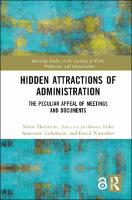Hidden Attractions of Administration
Proposal review
The Peculiar Appeal of Meetings and Documents
| dc.contributor.author | Åkerström, Malin | |
| dc.contributor.author | Jacobsson, Katarina | |
| dc.contributor.author | Andersson Cederholm, Erika | |
| dc.contributor.author | Wästerfors, David | |
| dc.date.accessioned | 2021-04-20T08:10:21Z | |
| dc.date.available | 2021-04-20T08:10:21Z | |
| dc.date.issued | 2021 | |
| dc.identifier | ONIX_20210420_9781000392272_14 | |
| dc.identifier | ONIX_20210420_9781000392272_14 | |
| dc.identifier | OCN: 1240830385 | |
| dc.identifier.uri | https://library.oapen.org/handle/20.500.12657/47882 | |
| dc.description.abstract | This book argues that the expansion of administrative activities in today’s working life is driven not only by pressure from above, but also from below. The authors examine the inner dynamics of people-processing organizations—those formally working for clients, patients, or students—to uncover the hidden attractions of doing administrative work, despite all the complaints and laments about "too many meetings" or "too much paperwork." There is something appealing to those compelled to participate in today’s constantly multiplying and expanding administration that defies popular framings of it as merely pressure from above. Hidden Attractions of Administration shows in detail the emotional attractiveness, moral conflicts, and almost magical features that administrative tasks often entail in today’s organizations, supported by ethnographic studies consisting of over 200 qualitative interviews and participant observations from ten organizational settings and contexts across Sweden. The authors also question and complement explanations in administration-related research that have previously been taken for granted, arguing that it is a simplification to attribute all aspects of the change to New Public Management and instead taking into account what the classic sociologist Georg Simmel called anEigendynamik: a self-reinforcing tendency that, under certain circumstances, needs only a nudge in an administrative direction to get going. By applying ethnography to issues of bureaucratization and meeting cultures and by drawing on findings in emotional sociology and social anthropology, this volume contributes to both the sociology of work and the study of human service organizations and will appeal to scholars and students working across both areas. | |
| dc.language | English | |
| dc.relation.ispartofseries | Routledge Studies in the Sociology of Work, Professions and Organisations | |
| dc.subject.classification | thema EDItEUR::J Society and Social Sciences::JH Sociology and anthropology::JHB Sociology | en_US |
| dc.subject.other | administration | |
| dc.subject.other | administrative work | |
| dc.subject.other | attractions | |
| dc.subject.other | bureaucratization | |
| dc.subject.other | documents | |
| dc.subject.other | Eigendynamik | |
| dc.subject.other | emotional attrativeness | |
| dc.subject.other | emotional sociology | |
| dc.subject.other | human service organizations | |
| dc.subject.other | meetings | |
| dc.subject.other | meeting cultures | |
| dc.subject.other | moral conflicts | |
| dc.subject.other | New Public Management | |
| dc.subject.other | pressure from above | |
| dc.subject.other | pressure from below | |
| dc.subject.other | Simmel | |
| dc.subject.other | sociology of organizations | |
| dc.subject.other | sociology of work | |
| dc.subject.other | working life | |
| dc.subject.other | work dynamics | |
| dc.title | Hidden Attractions of Administration | |
| dc.title.alternative | The Peculiar Appeal of Meetings and Documents | |
| dc.type | book | |
| oapen.identifier.doi | 10.4324/9781003108436 | |
| oapen.relation.isPublishedBy | 7b3c7b10-5b1e-40b3-860e-c6dd5197f0bb | |
| oapen.relation.isFundedBy | Lunds Universitet | |
| oapen.relation.isbn | 9781000392272 | |
| oapen.relation.isbn | 9781003108436 | |
| oapen.relation.isbn | 9780367622268 | |
| oapen.relation.isbn | 9780367622275 | |
| oapen.imprint | Routledge | |
| oapen.pages | 170 | |
| peerreview.anonymity | Single-anonymised | |
| peerreview.id | bc80075c-96cc-4740-a9f3-a234bc2598f1 | |
| peerreview.open.review | No | |
| peerreview.publish.responsibility | Publisher | |
| peerreview.review.stage | Pre-publication | |
| peerreview.review.type | Proposal | |
| peerreview.reviewer.type | Internal editor | |
| peerreview.reviewer.type | External peer reviewer | |
| peerreview.title | Proposal review | |
| oapen.review.comments | Taylor & Francis open access titles are reviewed as a minimum at proposal stage by at least two external peer reviewers and an internal editor (additional reviews may be sought and additional content reviewed as required). |

